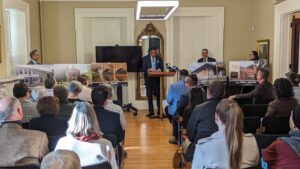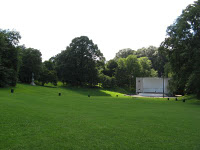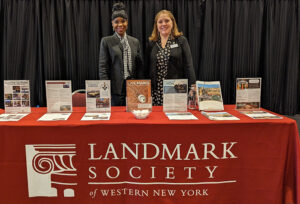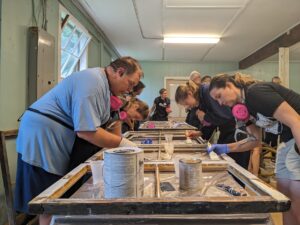
Flashback or Fast Forward–Rochester’s Highland Park
- August 18, 2011
- 1:43 pm
- August 18, 2011
- 1:43 pm
 Last summer, my husband and I took our four children to Rochester’s Highland Bowl, or should I say the John Dunbar Memorial Pavilion, ca. 1937, for the Monroe County Parks’ program “Free Movies in the Parks.” On one particular evening, the title was Back to the Future, originally released in 1985 when I was a sophomore in college. Fast forward 25 years and here I am procuring my own version of Back to the Future by taking my kids to the same spot where I first heard, saw, and fell in love with Rodgers & Hammerstein’s Carousel during the then popular “Opera under the Stars” series, probably around 1972.
Last summer, my husband and I took our four children to Rochester’s Highland Bowl, or should I say the John Dunbar Memorial Pavilion, ca. 1937, for the Monroe County Parks’ program “Free Movies in the Parks.” On one particular evening, the title was Back to the Future, originally released in 1985 when I was a sophomore in college. Fast forward 25 years and here I am procuring my own version of Back to the Future by taking my kids to the same spot where I first heard, saw, and fell in love with Rodgers & Hammerstein’s Carousel during the then popular “Opera under the Stars” series, probably around 1972.
We sat on the lawn in the beautifully landscaped park, enjoying the harmonious relationship of the amphitheater, a product of human hands, with the sloping hillside, carved from glaciers, a natural acoustic partner for the “Bowl.” The ampitheater or the “Bowl” as it is now widely referred to, was originally dedicated in 1937 to the late John Dunbar who is credited with the early establishment of the world class Lilac collection in Highland Park.
Many of our friends and neighbors who reside in the City of Rochester also attend these firefly-lit summer events. On this night, the crowd was surprisingly small for a gorgeous August evening. The potential crowd, I surmised, whittled down by the competing outdoor movie series screened on the same night in the nearby Towns of Brighton and Pittsford. My observation made me pause and consider the impact that sprawl and decentralization has had, and will continue to have, upon the oeuvre of childhood, and adult experiences alike which, only a generation ago could be shared with someone from 3 doors to more than 30 miles away. The collective memory and the vocabulary that comes from common experience, can be crucial as a launching point for discourse and understanding.
In the early days of the Bowl, the Rochester Philharmonic and other symphonic programs performed frequently during the spring and summer performance season. Today, a smattering of events are on the program annually, including Shakespeare in the Park, concerts, the movie series I attend with my family, and other community activities.
My suggestion: do your best to attend an event in the Highland Bowl, and if you have children, bring them. Look around and enjoy the legacy of Ellwanger, Barry, Olmsted, and Dunbar, while Frederick Douglass and Goethe look on. The first 20 acres of Highland Park was gifted by George Ellwanger & Patrick Barry in 1887. Their gift served as a catalyst for the establishment of the City’s Department of Parks, the hiring of internationally recognized landscape architect Frederick Law Olmsted, the establishment of an Olmsted designed park system in Rochester–one of four in the nation–and the cultivation of a world class botanical collection that draws millions annually. We are fortunate to be the recipients of decades of vision, philanthropy, and planning. The Highland Bowl site’s naturally occurring landscape was appropriately retained and maximized by people like Ellwanger, Barry, Olmsted, and Dunbar. It is an incomparable venue and should be part of every greater Rochesterian’s vocabulary.

Today, Thursday, August 18th is the last program of the summer for the “Free Movies in the Parks” series at the Highland Park Bowl.Adults can enjoy The King’s Speech, a quintessentially English film amongst a uniquely American cultural landscape.
Posted by Maranne McDade Clay, Grants Administrator
SHARE





1 thought on “Flashback or Fast Forward–Rochester’s Highland Park”
allright!!!
Comments are closed.